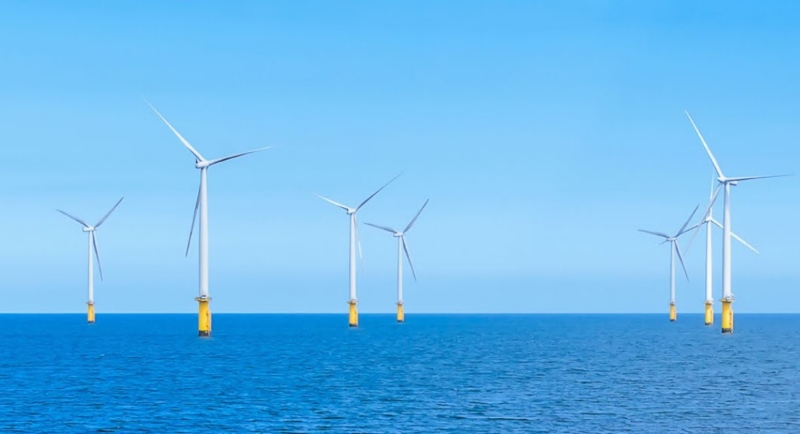Is Latin America Ready to Cope with Climate Change?
As global temperatures continue to rise with the global community stalled on any way to stop them, countries must prepare to adapt to increasingly volatile environmental conditions.
A Publication of The Dialogue
Colombia recently struck a deal with a Danish company to build an offshore wind farm in the Caribbean Sea, near the coastal city of Barranquilla. The offshore wind turbine facility—a first for Colombia—will generate 350 megawatts of electricity and could draw as much as $1 billion in investments, according to the energy ministry. What does the project, along with the solar farms popping up around the country, mean for Colombia’s transition to renewable energy? How does Colombia’s renewable energy strategy compare to other countries in the region, and how might the rise of renewables affect its oil and gas sector? Are there other forms of nonconventional sources of energy—such as green hydrogen, biomass and ocean wave energy—that Colombia should be prioritizing?
Diego Mesa, Colombia’s minister of mines and energy: “Colombia has advanced by leaps and bounds in our energy transition on a path to net zero. We have already multiplied by almost 30 times the 28 megawatts of nonconventional renewable capacity that came online in 2018. With new investments and agreements, Colombia will see an additional 2,876 megawatts generated from renewable energy come into operation in the coming months. We recently put into operation the first two green hydrogen pilot projects in the country, including the first green hydrogen project injected into the gas distribution network in Latin America. Natural gas is a transitional energy, necessary to decarbonize the transport industry and to give reliability to the electricity supply. Colombia stands out for its rapid progress in renewables. In our drive to build up diverse nonconventional renewable sources, we have achieved very competitive energy prices. Our robust legal and regulatory framework for these technologies—in addition to the great wealth of Colombia’s natural resources—helps us to strengthen our resilience against weather extremes and other climatic phenomena. Regarding offshore wind energy, it is an opportunity whose potential exceeds almost three times the current total installed renewable capacity in Colombia, with the potential to add about 50 gigawatts. This first project in Barranquilla will add to the transition that is already underway and is an indicator that Colombia is an attractive destination for investors in renewables. Our efforts in promoting renewables have already borne fruit. We do not perceive renewables as something that will surmount oil and gas, but rather complement those sources of energy. Oil is an important source of income for the country and key to the macroeconomic stability and social development for Colombians. But its extraction can be done in a sustainable, clean way.”
Karla Schiaffino, senior analyst of Latin America insights at Verisk Maplecroft: “In December 2020, the Colombian government increased its Nationally Determined Contribution to an ambitious 51 percent emissions reduction by 2030, as compared to a ‘business as usual’ trajectory. Verisk Maplecroft data shows this will require annual absolute emissions cuts of around 0.7 percent. To this end, state-owned Ecopetrol established a target of 400 megawatts generated through clean energy. Thus, the deal to build a wind farm is in line with the country’s plan to accelerate its energy transition. To double down in its decarbonization efforts, Colombia’s Energy Transition Law—enacted last July—incentivized the development of green hydrogen projects by introducing tax cuts. The law also regulates other energy sources, providing certainty for companies wanting to develop such projects. Moreover, in 2021 the government awarded a number of projects in two tenders, which are expected to increase the capacity from nonconventional sources by 12 percent by year-end. Nonetheless, Verisk Maplecroft data shows Colombia still lags behind other countries in the region—such as Argentina, Brazil and Ecuador—in terms of the support of the government for renewables. Despite the advancements, it should be noted that Colombia remains dependent on fossil fuels for energy self-sufficiency and extractives for macroeconomic stability. On official data, without the development on nonconventional hydrocarbon projects, Colombia has six years of oil reserves and seven years of natural gas. The next government will likely have to balance between the macroeconomic importance of the extractives industry and the country’s commitment to energy transition.”
Schreiner Parker, senior vice president and head of Latin America at Rystad Energy: “Colombia is poised for change, and necessarily so, when it comes to the energy transition. Traditionally, Colombia has been a major regional hydrocarbons player but now has a looming deficit in natural gas production that will make the country reliant on LNG imports for the near future to satisfy demand. This makes developing renewables even more attractive. Already, Colombia’s power mix is dominated by hydropower, which accounts for 70 percent of its power generation. However, due to natural phenomenon such as droughts, an overreliance on hydropower can be risky. Solar and wind are variable energy sources that create a more flexible baseload power source to accommodate times where there is a lot of wind and solar production and times where there is not as much. They are great solutions for diversifying away from reliance on a single source of power such as hydro. To pursue this diversification strategy, Colombia has so far relied on auctions. This is similar to the rest of Latin America and has been very successful up to now. In 2020, Colombia only had 196 megawatts of solar and wind capacity. In its first renewable energy auction in 2019, Colombia awarded 1.3 gigawatts of renewable capacity to eight projects. In the second auction in October 2021, 796.3 megawatts were awarded to 11 projects. These must be operational by January 2023. It’s important to remember that the penetration of renewables into the grid wouldn’t necessarily be detrimental to the hydrocarbons sector. Colombia could easily employ the Norwegian model, where they have a very green electricity network but continue their oil production and exports.”
Inés Elvira Vesga, partner at Holland & Knight: “There is a significant appetite for nonconventional energy sources, and Colombia has been adapting its regulations to favor self-generation, distributed generation and large-scale projects. The challenge for the country is to solve interconnectivity problems. These projects can be significant in terms of development and energy self-sufficiency if they are able to connect to the grid without any inconvenience and if environmental licenses can be obtained on reasonable terms. Colombia is taking orderly steps to achieve the energy transition, and the regulation follows the roadmap that the government designed. Natural gas will fuel the transition to renewables, and this was defined in the transition policy. As for oil, it will continue to be a major source of income. Colombia’s social investments depend on that income, so the development of renewables will not put oil and gas on the back burner. Chile, Uruguay, Brazil and Argentina are developing very interesting solar and wind projects and are leading the transition in South America. Chile is also betting big on green hydrogen and serves as an example for Colombia in the implementation of policies and regulatory changes for this fuel. Colombia’s geography favors wind projects, so this is a logical area of focus. Simultaneously, the number of solar projects taking place is increasing, and work is also being done on other sources such as biomass, geothermal and green hydrogen.”
John Padilla, managing director, and Sergio Torres, oil & gas and renewable energy consultant, both at IPD Latin America: “The MOU that the Barranquilla mayor’s office and Copenhagen Infrastructure Partners signed recently at CERAWeek in Houston represents the current government’s latest energy transition achievement. In renewables, three energy auctions have added 2.1 gigawatts of renewable energy in just over three years. This is expected to take renewables from 50 megawatts in 2018 to 2,500 megawatts this year. This would bring nonhydro renewable power up to 13 percent of Colombia’s generation mix. While Colombia does not have the solar irradiation levels or average wind speeds of Chile, Brazil or Argentina, it continues to retain a solid investment climate and overall stability, plus a wealth of biodiversity that is highly attractive from an energy transition perspective. With an energy transition law that has an electric mobility focus and a hydrogen roadmap in place, geothermal pilot projects are underway, along with goals of zero deforestation and a 51 percent cut in greenhouse gases by 2030, Colombia’s energy transition is moving full steam ahead and will remain solidly backed regardless of who is elected president this year. The only question is the speed and breadth of energy transition given the vital importance of extractive industries to government coffers and the overall economy. Both green and blue hydrogen will be pursued, the latter in large part due to significant coal production and reserves. With hydrogen pilot projects that both Ecopetrol and Promigas kicked off this month, Colombia is poised to be a leader in the region’s energy transition.”
Juanita Hernández Vidal, managing partner at the law firm Estudio Legal Hernández: “With the recent announcement by the mayor of Barranquilla about Colombia’s first large offshore wind power facility, the desire to start a new phase in the country’s energy transition is evident. But this is not the only project in development. There is great enthusiasm from other major multinationals to invest in offshore wind, for which the Colombian government has set the public policy in the roadmap published last year. The roadmap gives a range of scenarios for the growth of alternative energy sources – the most conservative estimates putting the growth of renewable power generation up by as little as 200 megawatts by 2030, and as high as 1 gigawatt of additional energy over the same period. Colombia has many mountain springs, making it an ideal place for hydroelectric power development. But past hydroelectric power projects have been riddled with problems in construction and maintenance. So, when it comes to renewables, the transition needs to focus on the development of energies that have a lower impact on the environment. There are multiple renewable options that Colombia should be exploring, such as kinetic energy and solar power, in which Colombia must venture, because the more diverse the generation matrix, the greater the confidence in the electricity grid. The type of renewable energy that becomes the most prominent in Colombia will be the one that’s the safest and most reliable and can balance the tradeoff between economic gain and environmental cost – and also complements conventional generation sources such as hydrocarbons.”
 The Latin America Advisor features Q&A from leaders in politics, economics, and finance every business day. It is available to members of the Dialogue’s Corporate Program and others by subscription.
The Latin America Advisor features Q&A from leaders in politics, economics, and finance every business day. It is available to members of the Dialogue’s Corporate Program and others by subscription.
As global temperatures continue to rise with the global community stalled on any way to stop them, countries must prepare to adapt to increasingly volatile environmental conditions.
As the global financial crisis continues to alter US relations with the hemisphere, greater engagement in the region remains critical to US interests.
With no time to lose, Colombia’s newly appointed Director of National Planning has gotten to work on an ambitious agenda.
 Colombia is investing heavily in renewable sources of energy, in line with its 2021 Energy Transition Law. An offshore wind farm in Britain is pictured. // File Photo: Colombian Government.
Colombia is investing heavily in renewable sources of energy, in line with its 2021 Energy Transition Law. An offshore wind farm in Britain is pictured. // File Photo: Colombian Government.
 Video
Video